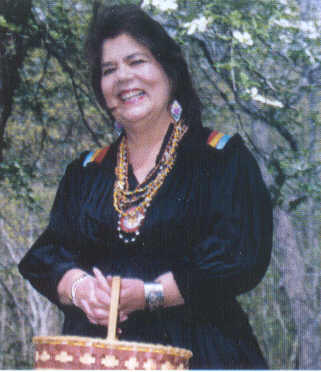
VOL.10 NO. 4 SPRING 2001
And Finally...
by Wilma Mankiller
|
The U celebrates Women’s Week 2001, “Breaking Boundaries: (Re)Constructing Activism,” March 2-9 with two keynote speakers, Angela Davis and Wilma Mankiller. Mankiller, former Principal Chief of the Cherokee Nation, will speak Tuesday, March 6, at 7:30 p.m. in the Saltair Room of the Olpin Union. The following
is excerpted from her autobiography, Mankiller: A Chief and
Her People (1993), and a speech given by Mankiller at Sweet Briar
College, both reprinted by permission of the author. |
If I am to be remembered, I want it to be because I am fortunate enough to have become my tribe’s first female chief. But I also want to be remembered for emphasizing the fact that we have indigenous solutions to our problems. Cherokee values, especially those of helping one another and of our interconnectedness with the land, can be used to address contemporary issues.
Rural development was, and still remains, a high priority on my list of goals. For me, the rewards came from attempting to break the circle of poverty. My feeling is that the Cherokee people, by and large, are incredibly tenacious. We have survived so many major political and social upheavals, yet we have kept the Cherokee government alive. I feel confident that we will march into the 21 st century on our own terms.
In a small community not even 15 miles from where I was raised and where my home is, many kids were dropping out of school, income for elders was less than $1,500 a year, 25 percent of the people were hauling water and had no indoor plumbing, many of the houses were dilapidated, and people settled disputes with violence. So we began working in this community because we absolutely believed that these people would rebuild and revitalize their community. I saw this as a way of rebuilding our tribe, community by community, family by family. We began meeting with people, asking them to talk about their own vision for the future and then prioritize what they wanted to do. We made a deal with them: we would bring the resources to them if they would decide how they wanted to rebuild their community and not only work on the leadership of it but on actually implementing it.
What they decided to do was rehab 20 of their homes, build 25 new homes using solar technology, and build a community water system. They agreed to do the building as volunteers, and we agreed to raise the money for the technical assistance and the resources. Now, when we went out and told people about this project and tried to raise money for the technical assistance and the physical resources, they thought we were crazy. They told us we shouldn’t even be out there by ourselves at night alone, that people in that community wouldn’t even work for a living, much less as volunteers. But we knew better.
The first day was the toughest for me. Everything I’d ever believed in my life about my own people was banking on people showing up and volunteering to rebuild their community. Driving to that community, rounding the bend, and seeing all the volunteers who had shown up and were ready to go to work was the most significant moment of my work I’ve ever experienced—far more significant than being elected chief. Every family in that community worked on rebuilding their water system, rebuilding their houses, rebuilding their community, and taking charge of their own future and their own lives again.
I think the most important issue we have as a people is to begin to trust our own thinking again and believe in ourselves enough to think that we can articulate our own vision of the future and then work to make sure that vision becomes a reality.
That’s a lot easier to say than it is to do. We’ve had a couple of hundred years of acculturation, the Cherokees probably more than anybody. We’ve been acculturated to believe that our religion is pagan, that our language is archaic and useless, and that our history doesn’t even exist (or it’s totally distorted when it is told). Our children go to public school systems in Oklahoma and see teachers that don’t look like them, don’t reflect who they are as a people. We’ve always been acculturated to believe that the Bureau of Indian Affairs or the Indian Health Service or somebody else had better ideas for us than we ourselves had. So trusting our own thinking—tearing it away from others and getting it back to us—is the single most important task we have ahead of us.
Today, we are helping to erase the stereotypes created by media and by western films of the drunken Indian on a horse, chasing wagon trains across the prairie. I suppose some people still think that all native people live in tepees and wear tribal garb every day. They do not realize that many of us wear business suits and drive station wagons. The beauty of society today is that young Cherokee men and women can pursue any professional fields they want and remain true to traditional values. It all comes back to our heritage and our roots. It is so vital that we retain that sense of culture, history, and tribal identity.
Continuum
Home Page - University of Utah Home
Page -
Alumni Association Home Page - Table of Contents
Copyright 2001 by The University of Utah Alumni Association
